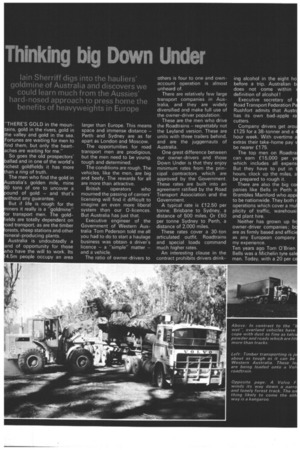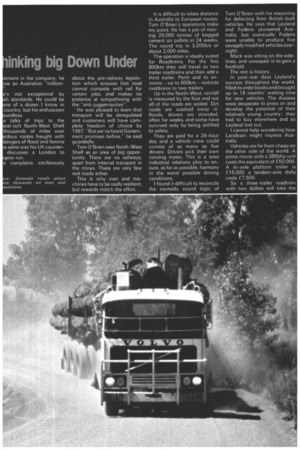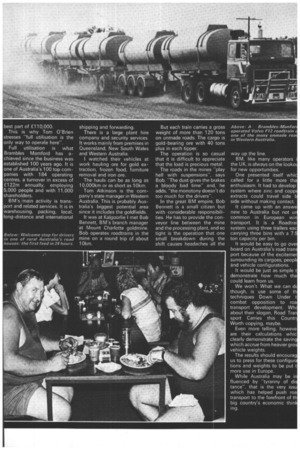Thinking big Down Under
Page 71

Page 72

Page 73

If you've noticed an error in this article please click here to report it so we can fix it.
lain Sherriff digs into the hauliers' goldmine of Australia and discovers we could learn much from the Aussies' hard-nosed approach to press home the benefits of heavyweights in Europe
"THERE'S GOLD in the mountains, gold in the rivers, gold in the valley and gold in the sea. Fortunes are waiting for men to find them, but only the heartaches are waiting for me."
So goes the old prospectors' ballad and in one of the world's richest goldfields it has more than a ring of truth.
The men who find the gold in Australia's golden mile, mine 80 tons of ore to uncover a pound of gold — and that's ithout any guarantee.
But if life is rough for the iners it really is a "goldmine" or transport men. The goldields are totally dependent on oad transport, as are the timber orests, sheep stations and other ineral-producing plants.
Australia is undoubtedly a and of opportunity for those ho have the will to work. Its 4.5m people occupy an area larger than Europe. This means space and immense distance — Perth and Sydney are as far apart as London and Moscow.
The opportunities for road transport men are prodigious, but the men need to be young, tough and determined.
The conditions are rough. The vehicles, like the men, are big and beefy. The rewards for all are more than attractive.
British operators who mourned the passing of carriers' licensing will find it difficult to imagine an even more liberal system than our 0-licences. But Australia has just that.
Executive engineer of the Government of Western Australia Tom Pederson told me all you had to do to start a haulage business was obtain a driver's licence — a "simple" matter — and a vehicle.
The ratio of owner-drivers to others is four to one and ownaccount operation is almost unheard of.
There are relatively few large transport companies in Australia, and they are widely diversified and make full use of the owner-driver population.
These are the men who drive the Roadtrains — regrettably not the Leyland version. These are units with three trailers behind, and are the juggernauts of Australia.
One great difference between our owner-drivers and those Down Under is that they enjoy minimum rates from the principal contractors which are approved by the Government. These rates are built into an agreement ratified by the Road Transport Association and the Government.
A typical rate is £12.50 per tonne, Brisbane to Sydney, a distance of 600 miles. Or £60 per tonne Sydney to Perth, a distance of 2,000 miles.
These rates cover a 30-ton articulated outfit. Roadtrains and special loads command much higher rates.
An interesting clause in the contract prohibits drivers drink mg alcohol in the eight ho before a trip. Australian b does not come within definition of alcohol !
Executive secretary of Road Transport Federation P: Rushfort admits that Austr. has its own bad-apple ra cutters Company drivers get arou £125 for a 38-tanner and a hour week. With overtime a extras their take-home pay be nearer £175 The top men on Roadtra can earn £15,000 per y: which includes all expens But they have to put in hours, clock up the miles, a be prepared to rough it There are also the big co panies like Bells in Perth a Brambles Marnford who app: to be nationwide. They both r operations which cover a rnul plicity of traffic, warehousi and plant hire.
Neither has grown up fro owner-driver companies, be are as firmly based and effici: as any European company my experience.
Ten years ago Tom O'Brien Bells was a Michelin tyre sal: man. Today, with a 20 per c: stment in the company, he ow an Australian "million e's not exceptional by sh standards. He could be me of a dozen I know in country, but his enthusiasm • undless.
e talks of trips to the eral-rich North-West Shelf thousands of miles over 1rdous routes fraught with dangers of flood and famine e same way his UK counter discusses a London to .gow run.
e complains vociferously about the pro-railway legislation which ensures that road cannot compete with rail for certain jobs, and makes no pretence at sympathising with the "anti -juggernauties".
He was pleased to learn that transport will be deregulated and customers will have complete freedom of choice by 1987. "But we've heard Government promises before," he said guardedly.
Tom O'Brien sees North-West Shelf as an area of big opportunity. There are no railways, apart from internal transport in the mines. There are very few real roads either.
This is why men and machines have to be really resilient, but rewards match the effort. It is difficult to relate distance in Australia to European routes. Tom O'Brien's operations make my point. He has a job of moving 29,000 tonnes of bagged cement on pallets in 24 weeks. The round trip is 3,200km or about 2,000 miles.
The operation is ideally suited for Roadtrains. For the first 800km they will travel as two trailer roadtrains and then add a third trailer. Perth and its environs — up to 800krn — restricts roadtrains to two trailers.
Up in the North-West, rainfall is measured by the foot and not all of the roads are sealed. Dirt roads are washed away in floods, drivers are stranded, often for weeks, and some have survived only by being airlifted to safety.
They are paid for a 24-hour day and a vehicle crew could consist of as many as five drivers. Drivers pick their own running mates. This is a wise industrial relations ploy to ensure, as far as possible, harmony in the worst possible driving conditions.
I found it difficult to reconcile the normally sound logic of Tom O'Brien with his reasoning for defecting from British-built vehicles. He says that Leyland and Fodens pioneered Australia, but eventually Fodens were unable to produce five savagely modified vehicles overnight.
Mack was sitting on the sidelines, and swooped in to gain a foothold.
The rest is history.
In post-war days Leyland's success throughout the world, filled its order books and brought up to 18 months' waiting time for new vehicles. The Aussies were desperate to press on and develop the potential of their relatively young country; they had to buy elsewhere and so Leyland lost out.
I cannot help wondering how Landtrain might impress Australia.
Vehicles are far from cheap on the other side of the world A prime mover with a 385bhp unit costs the equivalent of £50,000 A tri-axle platform trailer is £15,000, a tandem-axle dolly costs £7,500.
So a three-trailer roadtrain with two dollies will take the best part of £110,000.
This is why Tom O'Brien stresses "full utilisation is the only way to operate here".
Full utilisation is what Brambles Mamford has achieved since the business was established 100 years ago. It is one of Australia's 100 top companies with 184 operating centres, a turnover in excess of £122m annually, employing 5,000 people and with 11,000 shareholders.
BM's main activity is transport and related services. It is in warehousing, packing, local, long-distance and international shipping and forwarding.
There is a large plant hire company and security services. It works mainly from premises in Queensland, New South Wales and Western Australia.
I watched their vehicles at work hauling ore for gold extraction, frozen food, furniture removal and iron ore.
The hauls can be as long as 10,000km or as short as 10km.
Tom Atkinson is the company's state manager in Western Australia. This is probably Australia's biggest potential area since it includes the goldfields.
It was at Kalgoorlie I met Bob Bennett, BM's branch manager at Mount Charlotte goldmine. Bob operates roadtrains in the mine on a round trip of about 10km. But each train carries a gross weight of more than 120 tons on unmade roads. The cargo is gold-bearing ore with 40 tons plus in each tipper.
The operation is so casual that it is difficult to appreciate that the load is precious metal.
The roads in the mines "play hell with suspensions", says Bob. "The dust gives the brakes a bloody bad time" and, he adds, "the monotony doesn't do too much for the drivers".
In the great BM empire, Bob Bennett is a small citizen but with considerable responsibilities. He has to provide the conveyor line between the mine and the processing plant and so tight is the operation that one small breakdown during the shift causes headaches all the way up the line.
BM, like many operators the UK, is always on the looko for new opportunities.
One presented itself whic called for a little more tha enthusiasm. It had to develop system where zinc and copp extracts could travel side side without making contact It came up with an answe new to Australia but not ur common in European win transport. It is a Roadtrai system using three trailers eac carrying three bins with a 7. ton capacity per bin.
It would be easy to go ove board on Australia's road tran port because of the excitemer surrounding its cargoes, peopl and vehicle configurations.
It would be just as simple t demonstrate how much the could learn from us.
We won't. What we can d though, is use some of th techniques Down Under t combat opposition to roa transport development. Whc about their slogan, Road Tran sport Carries this Countr Worth copying, maybe.
Even more telling, howeve are their calculations whic clearly demonstrate the saving which accrue from heavier gro. vehicle weights.
The results should encou rag us to press for these configura tions and weights to be put t more use in Europe.
While Australia may be in fluenced by "tyranny of di tance", that is the very issu which has helped push roa transport to the forefront of th big country's economic thin ing.












































































































































